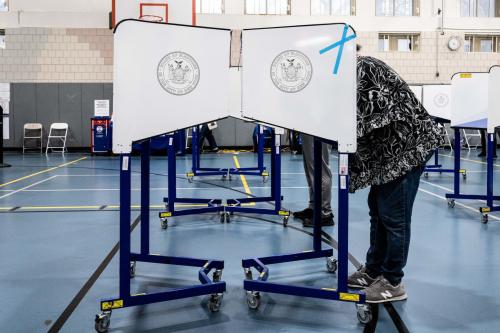Content from the Brookings Institution India Center is now archived. After seven years of an impactful partnership, as of September 11, 2020, Brookings India is now the Centre for Social and Economic Progress, an independent public policy institution based in India.
Quality
- Focus on Learning Outcomes: There is an unequivocal need for the education system to shift its focus from access and infrastructure to improving learning outcomes for all students in the country. While some basic standards for infrastructure are needed, greater priority should be given to learning outcomes in the school recognition process. At the same time, there is a need to move beyond a curriculum-centred approach to education, to broaden education goals to include children’s physical, emotional, and social well-being, and their ability to ‘learn how to learn’
- Education Goals and Testing Should Be Context-Specific: While there is a global demand for determining what learning is important and how it should be measured, it is crucial that such goals and testing mechanisms be context-specific, accounting for the important societal, linguistic, and cultural aspects of education, and enabling learning to be successful in life and livelihood, which is highly dependent on the village, city, state, and country where they live.
- Develop Mechanisms to Measure Learning Outcomes: Measuring learning outcomes is crucial as it provides information about where we are and where we want to go, and sets benchmarks for performance for all stakeholders. Current assessments – NAS and SLAS – face constraints in capacity, and need to be made more informative and robust to be useful for education transformation. Assessments should generate a transition from ‘learning for testing’ to ‘testing for learning’, and de-emphasise rote learning. In addition, such testing should happen across the education system – in both public and private schools.
- Use Assessments to Manage Quality: The purpose of learning assessments is not just to measure, but also to provide actionable information that feeds back into the education system, and is acted upon to improve learning. Assessments should designed so that they are able to provide direction about what needs to be done at the level of policy, teacher training, teaching learning materials, and curriculum. Capacity needs to be built in this regard, among test-designers, policymakers, and school leaders and teachers
- Recognise the Central Role of Teachers: The role of teachers is critical in improving the quality of education and learning levels, as they are the primary connection to students. The teacher’s role also needs to be seen through a wider lens – apart from teaching within the classroom, teachers must understand their students’ backgrounds and work closely with parents and communities to address any challenges to their students’ education. Against this backdrop, teachers must be given the time and space to innovate, and trained appropriately to respond to challenges they face on the job.
- Train Teachers and School Leaders to Improve Learning Outcomes: Teacher training must expand to include training in psychometrics and alternate learning methods. School leaders should be seen as motivators of teacher performance and the drivers of quality within their schools. Currently, school leaders receive almost no in-service training or mentorship, and their career trajectories do not prepare them for their responsibilities as leaders. Both teachers and school leaders must be trained to understand and make use of data generated by learning assessments, to improve the quality of pedagogy within their classrooms and schools.
Access
- Focus on Retention Instead of Just Access, Especially for Marginalised Communities: There are two broad sets of challenges that need to addressed: the nature of education provided within schools, and broader household and societal factors. Schools need to address the ‘push out’ factors: poor quality, indifferent teaching, and irrelevant curricula. The wider community must be involved to address the societal ‘pull out’ factors, by educating and involving parents, advocating for marginalised students, and building a support network for first generation learners.
- Recognise Supplementary & Remedial Education as a Crucial Complement to the Mainstream System: Supplementary and remedial instruction has become pertinent given the large inequalities in learning, and diversity in student backgrounds. Its role has been found to be particularly relevant for first-generation learners, students from economically and socially disadvantaged backgrounds, and girls who may lack the resources and support within their families and communities.
- Government Should Play the Role of a Facilitative Regulator: Currently, private schools contend with a complex regulatory framework of rules, notifications, and judgments from multiple stakeholders with unaligned objectives. Stringent input-related norms have also caused several budget private schools to face closure. There is need for a new approach to regulation that eases input norms, while empowering schools to innovate in the customisation of instruction, staffing, and other decisions affecting student outcomes.
- Create Greater Transparency and Accountability in the School System: There is a need to balance increased autonomy to school systems, with greater transparency and accountability to students’ learning levels and outcomes. Assessments should be designed for all schools – public or private – and their performance should be made publically available for all stakeholders in the sector.
Acceleration
- Leverage Technology to Generate Systemic Change: Moving beyond providing access to technology, the data-generation ability of technology may be used to nudge the system towards a greater outcome focus. At the micro-level, such data may be used to understand student needs and individualise pedagogy, while at the macro-level, such data may be used to develop dashboards and management information systems towards greater transparency.
- Government Support is Crucial for Innovations to Scale: While conducting experiments and testing innovations, it is important for public and non-state actors to collaborate. The government has the scale and brings deeper pockets, while the private sector is often more efficient, nimble and able to innovate. Experiments and innovations that have successfully scaled have built in government ownership as early as possible, and have leveraged existing government resources and infrastructure.
- Facilitate Collaboration and Knowledge-Sharing At All Levels: Communication and collaboration between teachers, school leaders, policymakers, as well as education entrepreneurs and innovators, across the system should be encouraged to share best practices and facilitate the scaling of successful experiments and innovations.
- To Create a Culture of Innovation, Facilitate Systemic Change: To facilitate innovations, we must start with clearly defining the problems, establishing appropriate criteria, which must include measurability of outcomes, cost-effectiveness and scalability. A combination of training, change in mindsets to view teachers as the primary connection to students, and institutional support to provide the right guidance and incentives, is needed to generate a systemic change to unleash the inherent potential for problem-solving.
- Incentivise Entrepreneurship in Education: Entrepreneurship in education must be encouraged through early and development stage funding, tax and fiscal incentives, incubation hubs and research labs. A centralised information-sharing mechanism that provides a comprehensive survey of experiments and innovations around the world is crucial to create a functioning innovation ecosystem.


Commentary
Op-edKey Policy Insights
Accelerating Access to Quality Education
June 28, 2015